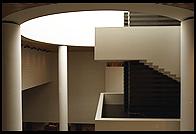
Canon EOS 5 / A2E
by Philip Greenspun; created 1997
Site Home : Photography : Canon EOS 5 / A2E
I bought the EOS-5 after reading an article by a photojournalist in which he said that the eye-tracking autofocus gave him sharper pictures. He didn't have to jostle the camera with his hands to focus manually or do the "center the AF target on subject, press shutter release halfway, recompose for final image" Nikon dance.
Eye tracking never worked for me, but I still like many things about the camera.
I didn't fall in love with my EOS-5s until someone on the Net told me about Custom Function 4. This moves autofocus from the shutter release to a button under your right thumb. If you have a lens with an ultrasonic motor, you can leave the lens in AF mode for AF or MF. When you want to focus, turn the ring on the lens or push the button under your thumb. You make a conscious decision. If your subject stays at the same distance and you don't feel the need to refocus, you need not.
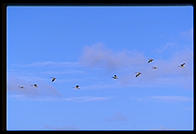 AF turned my Nikons into enemies.
You'd be tracking an animal in your viewfinder, about to take that great slide,
and AF sensor would seize on a cloud in the background or a blade of grass in the
foreground. You'd be cursing and frustrated while the puny screwdriver blade in
the camera tried to rack the huge mass of the 80-200/2.8 from infinity to close
focus and back.
AF turned my Nikons into enemies.
You'd be tracking an animal in your viewfinder, about to take that great slide,
and AF sensor would seize on a cloud in the background or a blade of grass in the
foreground. You'd be cursing and frustrated while the puny screwdriver blade in
the camera tried to rack the huge mass of the 80-200/2.8 from infinity to close
focus and back.
Custom Function 4 means that you can have AF and still have the camera as your partner. The instant AF of the Canon in-lens motors is a nice bonus.
[Note: you need an ultrasonic motor to have simultaneous MF and AF. That's one good reason never to buy an off-brand lens for your Canon EOS.]
If you wear eyeglasses, you'll find that all Canon SLRs have inferior viewing systems. A combination of eyepoint and exit pupil size means that you probably won't be able to see the whole frame and displays. Even if you don't wear eyeglasses, you'll probably find it more difficult to focus manually with the standard Canon screens. Perhaps the Canon screen is slightly brighter than on a Nikon 8008 or N90, but with those cameras even fast wide angle lenses snap in and out of focus overall. I've lost quite a few pictures with my EOS-5 and 20-35/2.8 because the image looked basically sharp but wasn't (I would have had the lens set to MF for some tripod work).
Don't hold your breath for any improvement in this area. I spoke with a Canon USA technical expert and he said that they've been complaining to the engineers back in Japan about the smaller-than-Nikon exit pupil, to no avail.
I find Canon's matrix meter to be less intelligent than Nikon's. Bracket, think, and use negative film.
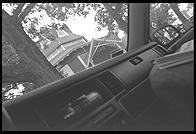 You must have a VG-10 vertical grip. It duplicates the important controls for
your thumb and forefinger (shutter release, main control wheel, CF4 button, and
AF sensor select) and therefore the camera user interface remains stable relative
to your hand even when you change to vertical format. After playing with this
setup for one minute, I didn't miss the on-lens aperture ring from my Nikons.
You must have a VG-10 vertical grip. It duplicates the important controls for
your thumb and forefinger (shutter release, main control wheel, CF4 button, and
AF sensor select) and therefore the camera user interface remains stable relative
to your hand even when you change to vertical format. After playing with this
setup for one minute, I didn't miss the on-lens aperture ring from my Nikons.
Every camera I've ever owned with more than one shutter release has yielded plenty of surprise photos. Here's one from Cape Cod.
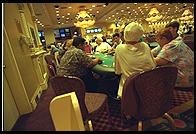 A second shutter release
is quite convenient when photography isn't allowed (e.g., in this Atlantic City
casino) and you don't want to be seen with your hands on what the security people
would think of as the controls.
A second shutter release
is quite convenient when photography isn't allowed (e.g., in this Atlantic City
casino) and you don't want to be seen with your hands on what the security people
would think of as the controls.
Stupid, stupid, stupid. Compared to Nikon and even evaluated on its own merits, the Canon flash system reeks of bad engineering. If you have an off-center subject and try to use fill flash, you will be one sorry person. Note the horribly overfilled image at left, where the flash was set to -1.3 stops exposure. A Nikon N90 would have done a perfect job here, computing the appropriate flash power from the lens focus distance rather than from how much was returned from an office building in the center of the frame.
AF assist at night is another area where the EOS-5 falls on its face. Since the camera has five AF sensors and Canon's accessory flashes wouldn't cover the full width, the EOS-5 won't enable any accessory flash AF assist light. Instead it turns on its built-in light, which is obscured by any professional lens.
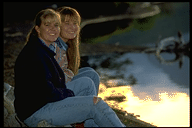 If you
spend $300 on a 540EZ flash, which does have a wide enough AF assist light
coverage, the EOS-5 still won't turn it on. Canon's engineers didn't have enough
foresight to build some room for expansion into their flash standard. Nikon isn't
really a lot better in this respect; they bring out a new flash and new flash
communication standard with just about every new body, but at least their stuff
works. (The image at right, from
Travels
with Samantha, Chapter V, was taken with an old 8008/SB-24 with none of the
fancy D stuff, but it is still way better than what you'd get out of the
EOS-5.)
If you
spend $300 on a 540EZ flash, which does have a wide enough AF assist light
coverage, the EOS-5 still won't turn it on. Canon's engineers didn't have enough
foresight to build some room for expansion into their flash standard. Nikon isn't
really a lot better in this respect; they bring out a new flash and new flash
communication standard with just about every new body, but at least their stuff
works. (The image at right, from
Travels
with Samantha, Chapter V, was taken with an old 8008/SB-24 with none of the
fancy D stuff, but it is still way better than what you'd get out of the
EOS-5.)
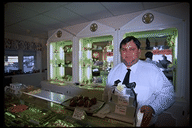 The on-camera flash
in the EOS-5 is basically useless. It isn't high enough to see around most
professional lenses. You therefore end up with big shadows (see image at left,
from my
Footsteps travelogue). It would be very
nice for adding catchlights to subjects' eyes when you were using an accessory
flash in bounce mode, but the on-camera flash turns off as soon as you plug in an
accessory flash. Let me add that one time in
Costa
Rica, the on-camera flash saved my butt when I was up in a tree with no other
flash and a sloth crawled within 10' (see image at right).
The on-camera flash
in the EOS-5 is basically useless. It isn't high enough to see around most
professional lenses. You therefore end up with big shadows (see image at left,
from my
Footsteps travelogue). It would be very
nice for adding catchlights to subjects' eyes when you were using an accessory
flash in bounce mode, but the on-camera flash turns off as soon as you plug in an
accessory flash. Let me add that one time in
Costa
Rica, the on-camera flash saved my butt when I was up in a tree with no other
flash and a sloth crawled within 10' (see image at right).
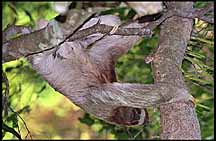 To add final insult to
injury, considering how many flash shots the EOS-5 blows, there is no in-camera
flash exposure confirmation light. An old Nikon 8008 will warn you with a
flashing lightning bolt that you didn't get enough light onto that last picture,
but unless you have the 540 EZ and remember to take your eye away from
the finder to look at the light on the flash, you won't know that you lost the
shot until you go to the lab.
To add final insult to
injury, considering how many flash shots the EOS-5 blows, there is no in-camera
flash exposure confirmation light. An old Nikon 8008 will warn you with a
flashing lightning bolt that you didn't get enough light onto that last picture,
but unless you have the 540 EZ and remember to take your eye away from
the finder to look at the light on the flash, you won't know that you lost the
shot until you go to the lab.
The EOS-5 is the quietest SLR I've used. With the EOS-5 and a 20mm perspective, not only do people not realize that they are in the picture they don't realize that you are taking pictures. This has been a marvelous gift when I've been doing photojournalism and the only time it has been a handicap is during fashion photography. Models are used to breaking their pose when they hear the motor drive click, but even with only a 200mm lens they are too far from the EOS-5 to hear it operating so you have to tell them when to change expression.
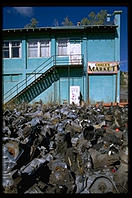 I have two EOS-5s that have exposed more
than 600 rolls of film in 18 months. They've gotten wet in the Costa Rica
rainforest, sandy at the beach, and taken some knocks, but they show no sign of
quitting. The plastic case seems to absorb shock and hide scars very well. I've
never had a failure on any of my Canon equipment (2 bodies, 7 lenses, 2 flashes).
By contrast, my Nikon 8008 matrix meter died after a few months and a 20/2.8 AF
lens suffered internal damage despite careful handling.
I have two EOS-5s that have exposed more
than 600 rolls of film in 18 months. They've gotten wet in the Costa Rica
rainforest, sandy at the beach, and taken some knocks, but they show no sign of
quitting. The plastic case seems to absorb shock and hide scars very well. I've
never had a failure on any of my Canon equipment (2 bodies, 7 lenses, 2 flashes).
By contrast, my Nikon 8008 matrix meter died after a few months and a 20/2.8 AF
lens suffered internal damage despite careful handling.
Someone has a U.S. patent, believe it or not, on the use of a digital scale to show under or over exposure in a metered-manual SLR. Canon didn't want to pay this patent holder and therefore turns off the -2/+2 (in half-stops) scale when in metered-manual mode. You get just an over or under indication but have no way of telling how much without dialing back to neutral and counting. The European/Japanese market EOS-5 is not crippled in this manner. B&H Photo and Adorama in New York carry the grey market camera.
Note: Canon USA will honor the warranty on any Canon product purchased anywhere in the world. Since it is all one company, they are basically required to do this by state law in any state that has typical commercial laws. Of course, most Fortune 500 companies don't really think they have to comply with any law if the entity on the other side is a mere consumer. So let's give Canon credit for this. Anyway, don't let a retailer sell you an extra cost U.S. warranty.
The EOS-5 is a fabulous professional-grade tool at a consumer price. It has its shortcomings and they can drive you to distraction because they seem so unnecessary, but I feel on balance that it is the best camera in the Canon line.
Text and pictures (c) copyright 1991-1997 Philip Greenspun.